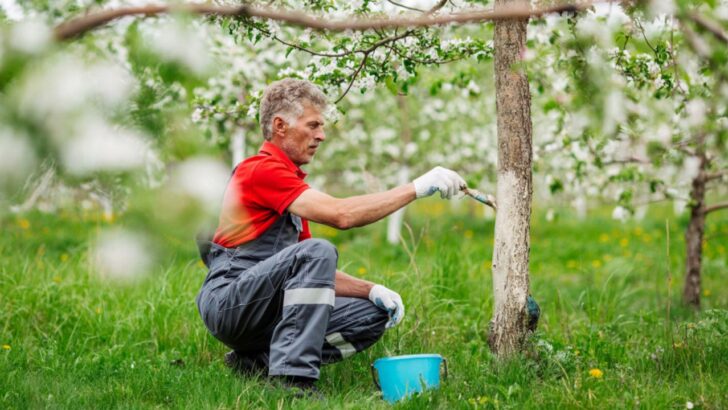You know how you feel crispy and look like a lobster after a long day in the sun without sunscreen and a wide-rimmed hat? Well, turns out your fruit trees might feel the same way. Sunburns aren’t just a human thing. Fruit trees, especially young ones, can get scorched by the sun, and when that happens, they stop putting energy into growing juicy peaches or crisp apples and start focusing on healing.
That’s why @epicgardening says he paints all of his fruit trees. It’s not some artsy garden trend, though it does look cool. It’s an old-school, science-backed way to protect your trees and keep them productive. Let’s break down why grabbing a bucket of paint might be one of the smartest things you do for your orchard this year.
Trees Get Sunburns, Too
Okay, technically it’s called sunscald in the tree world, but it’s the same idea as sunburn. The sun, especially in winter and early spring, hits the bark of your tree hard, usually on the southwest side. The heat can cause the bark to expand during the day, and when temperatures suddenly drop at night, it cracks. The bark splits, and the tree has to pause everything—including fruit production—to heal.
Painting the trunk with a 1:1 mix of white latex paint and water helps reflect sunlight and keeps the bark temperature stable. It’s like giving your tree its own SPF 50.
Goodbye Bugs, Hello Fruit
Ever met a bug that didn’t like cozy, dark crevices? Me neither. Cracked bark from sun damage becomes a hideout for pests—borers, beetles, and even fungal infections. Once they move in, they feast on the tree’s sap and wood.
Painting helps prevent that cracking in the first place. Fewer cracks mean fewer hiding places for pests. Some gardeners swear that painted trunks make it harder for crawling bugs like ants (and even aphids) to climb up on your fruit trees. And if you’ve ever had to deal with aphid goo, you know that’s a win.
It Helps During Wild Temperature Swings
Ever had one of those weird spring weeks where it’s sunny and 75°F one day and snowing the next? Your fruit trees hate that. The paint helps buffer against those temperature swings, especially in early spring when the sap starts flowing and a sudden freeze can cause serious damage.
By keeping the trunk a little more chill, you’re giving your tree a better shot at blooming on time and producing solid fruit.
It’s Cheap, Easy, and Kind of Fun
Here’s the fun part—painting your trees is super easy. All you need is white latex (not oil-based) paint and water. Mix it half and half, grab a brush, and slap it on the bottom two feet of the trunk (at minimum). That’s it. You don’t need a ladder, and you don’t need to call in the professionals.
If you’ve got kids, this is a great Saturday morning project. If you’re solo, crank up some music and get into your tree-painting zen mode.
It Can Make Your Garden Look Prettier
A painted tree trunk adds a bit of charm. There’s something timeless and almost Mediterranean about that white base. It’s been a common sight in orchards in Greece, Mexico, and parts of the southern U.S. for generations. Sometimes they mix in lime instead of paint, which helps repel insects and fungi.
What to Watch After Painting
Once your trees are painted, don’t just forget about them—use them as a baseline. That bright white trunk makes it easier to spot problems early. If the sap is oozing, it could be borers. Paint peeling oddly? It might mean moisture issues. Cracks forming despite the paint? Time to reassess your sun exposure or watering routine.
The paint protects your tree while turning it into its own alert system. And that’s a smart move for any gardener who wants more fruit and fewer surprises.


